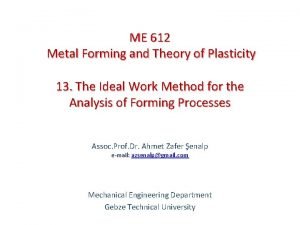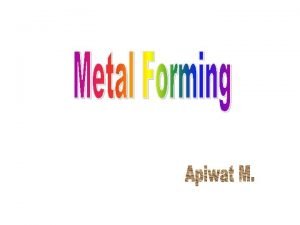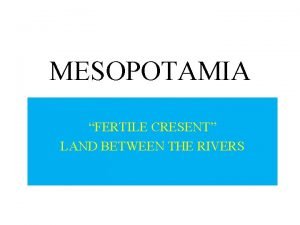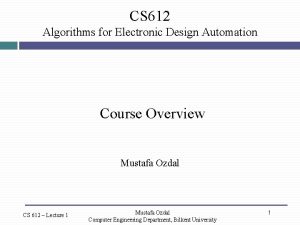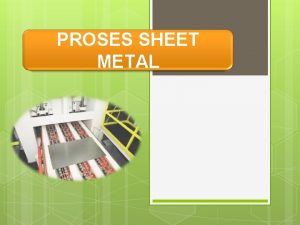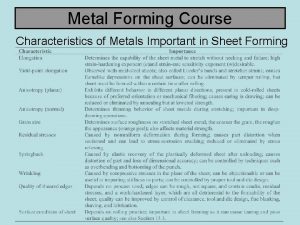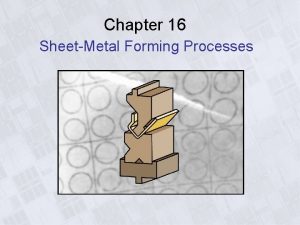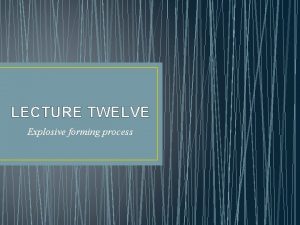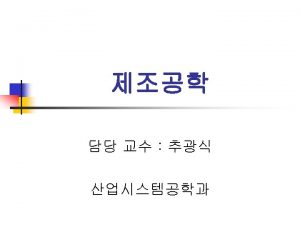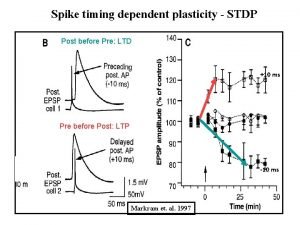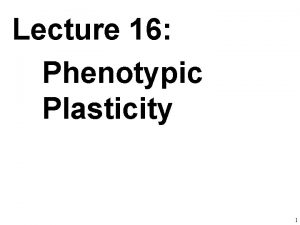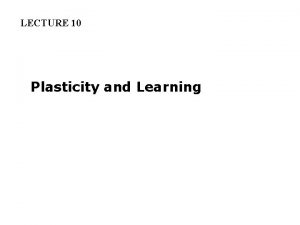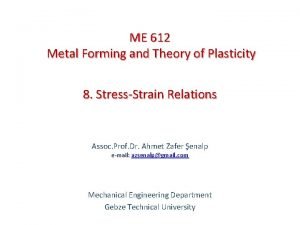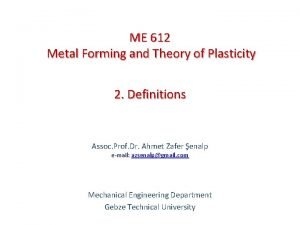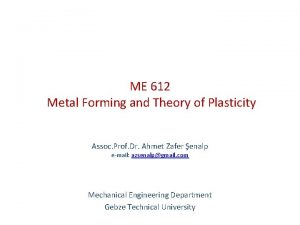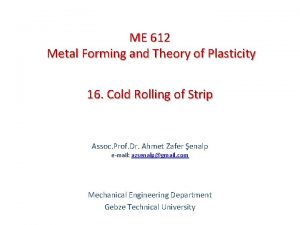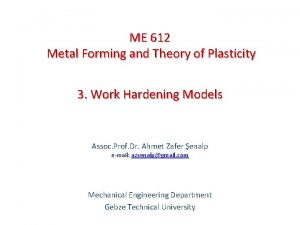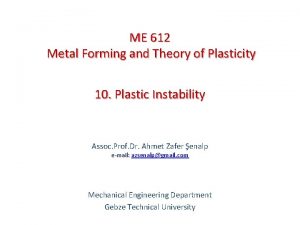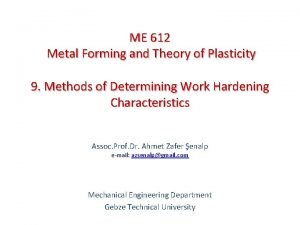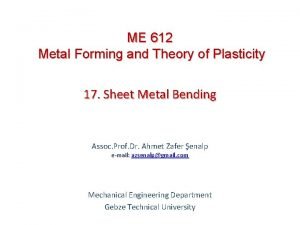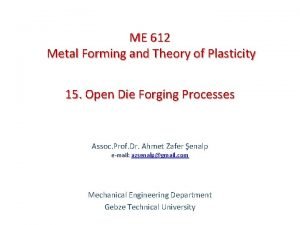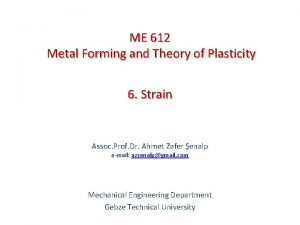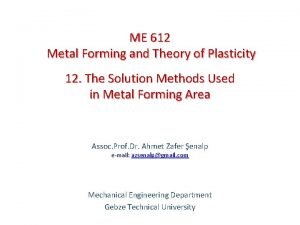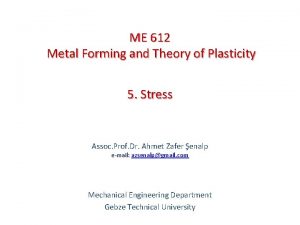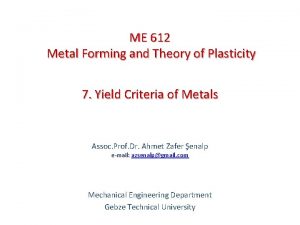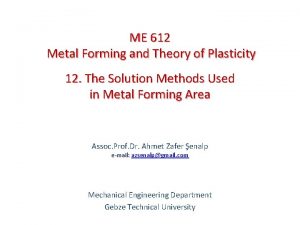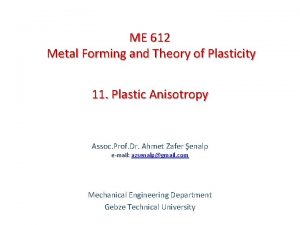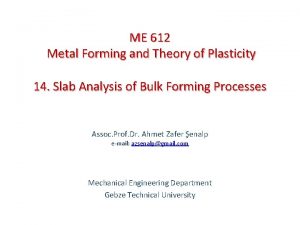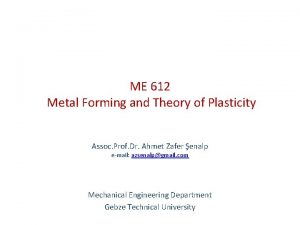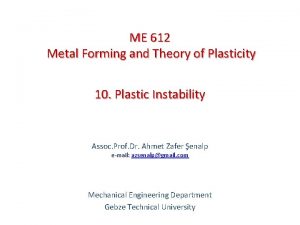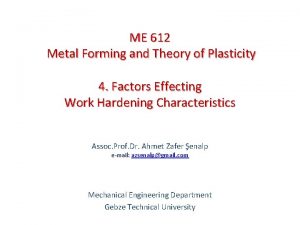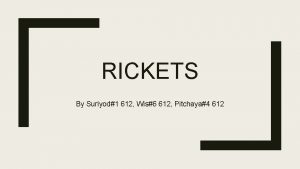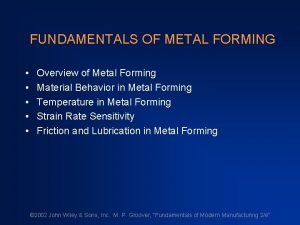ME 612 Metal Forming and Theory of Plasticity



























- Slides: 27

ME 612 Metal Forming and Theory of Plasticity 7. Yield Criteria of Metals Assoc. Prof. Dr. Ahmet Zafer Şenalp e-mail: azsenalp@gmail. com Mechanical Engineering Department Gebze Technical University

7. Yield Criteria of Metals Recall that we say that the material yields when it exhibits an irreversible straining which is sustained once a certain level of the stress distribution is reached. A yield criterion indicates for which combination of stress components transition from elastic (recoverable) to plastic (permanent) deformations occurs. In one-dimension (Fig. 7. 1(a)) yielding occurs when the uniaxial stress reaches the value of the yield stress Y in tension, i. e. at σ = Y. When does ‘yielding’ occur in multi-axial stress states? (Fig. 1(b))? The answer is given with phenomenological theories called ‘yield criteria’. Instead of presenting the requirements and constraints for a general form of a yield criterion, we will here only examine the two most important yield criteria for isotropic materials. Dr. Ahmet Zafer Şenalp ME 612 Figure 7. 1. (a) To define yielding in onedimensional stress states, we compare the uniaxial stress σ with the yield stress in tension Y. (b) When does yielding occurs in multidimensions? Mechanical Engineering Department, GTU 2

7. Yield Criteria of Metals The most general form of yield criteria is: (C= a constant) (7. 1) Or in terms of principal stresses; (7. 2) For most ductile metals that are isotropic, the following assumptions are invoked since they have been observed in many instances: 1. There is no Bauschinger effect, thus the yield strengths in tension and compression are equivalent. 2. Constancy of volume prevails so the plastic equivalent of Poisson’s ratio is 0. 5. 3. The magnitude of mean normal stress; yielding. (hydrostatic stress) does not influence (7. 3) Dr. Ahmet Zafer Şenalp ME 612 Mechanical Engineering Department, GTU 3

7. Yield Criteria of Metals In Figure 7. 2 two different stress states is given where the only difference is the hydrostatic stress. These two cases are equivalent in terms of yield criteria. Figure 7. 2. Mohr’s circles showing two stress states which differ by only a hydrostatic stress. Dr. Ahmet Zafer Şenalp ME 612 Mechanical Engineering Department, GTU 4

7. Yield Criteria of Metals Yield crteria can be expressed as: (7. 4) Dr. Ahmet Zafer Şenalp ME 612 Mechanical Engineering Department, GTU 5

7. 1. The Tresca Criterion or the Maximum Shear Stress Criterion 7. Yield Criteria of Metals This criterion postulates that yielding will occur when the largest shear stress reaches a critical value. or (7. 5) (7. 6) (C= Constant) and this equality is Tresca criterion. (For principal stresses rule is valid) To find the value of C uniaxial tension test case can be handled. In this test conditions apply and yield occurs when value is equal to yield strength value; (7. 7) Hence Dr. Ahmet Zafer Şenalp ME 612 Mechanical Engineering Department, GTU 6

7. 1. The Tresca Criterion or the Maximum Shear Stress Criterion 7. Yield Criteria of Metals Considering pure shear case: conditions apply and yield occurs when maximum shear stress value is equal to shear strength value. In this case; (7. 8) then (7. 9) and Tresca criterion is Dr. Ahmet Zafer Şenalp ME 612 Mechanical Engineering Department, GTU 7

7. 1. The Tresca Criterion or the Maximum Shear Stress Criterion 7. Yield Criteria of Metals Figure 7. 3. Tresca yield locus. Dr. Ahmet Zafer Şenalp ME 612 Mechanical Engineering Department, GTU 8

7. 2. Examples of the application of the Tresca criterion 7. Yield Criteria of Metals Example 1: Equi-biaxial tension; σ1=σ2=�and σ3=0 (Figure 7. 4) Figure 7. 4. Equi-biaxial tension σ1=σ2=�ve σ3=0 The principal stresses are: Dr. Ahmet Zafer Şenalp ME 612 Mechanical Engineering Department, GTU 9

7. 2. Examples of the application of the Tresca criterion 7. Yield Criteria of Metals In this case stress state according to Figure 7. 3 is at the intersection point of regions 1 and 2. Both regions can be used. we conclude that yielding in equi-biaxial tension occurs when Dr. Ahmet Zafer Şenalp ME 612 Mechanical Engineering Department, GTU 10

7. 2. Examples of the application of the Tresca criterion 7. Yield Criteria of Metals Example 2: Hydrostatic pressure case; σ1=σ2=σ3=-p are principal stresses. is obtained and this is never equal to Y. Then in pure hydrostatic stress case yield never happens. Dr. Ahmet Zafer Şenalp ME 612 Mechanical Engineering Department, GTU 11

7. 2. Examples of the application of the Tresca criterion 7. Yield Criteria of Metals Example 3: Stress state is given as: The material of this parts does not yield. If additional 50 MPa fluid pressure is applied to the part will there be yielding? At the beginning; Fluid pressure adds extra -50 MPa to the above stresses. Dr. Ahmet Zafer Şenalp ME 612 Mechanical Engineering Department, GTU 12

7. 2. Examples of the application of the Tresca criterion New situation is 7. Yield Criteria of Metals then; This case yields the same diameters with the initial one in Mohr’s circle. This example shows that hyrostatic pressure does not effect yield. Dr. Ahmet Zafer Şenalp ME 612 Mechanical Engineering Department, GTU 13

7. 2. Examples of the application of the Tresca criterion 7. Yield Criteria of Metals Example 4: A metal has a yield stregth of 280 MPa. This metal is loaded such that 300 MPa, 200 MPa and 50 MPa principal stresses appear. Will this metal yield according to Tresca criterion? According to given stress values; � σmin = 50 MPa max = 300 MPa If replaced in Tresca criterion; < Y=280 MPa means that metal will not yield. Dr. Ahmet Zafer Şenalp ME 612 Mechanical Engineering Department, GTU 14

7. Yield Criteria of Metals 7. 3. The von-Mises Yield Criterion Another function that can be used for yield is (7. 10) To find the value of C uniaxial tension test case can be handled. In this test when value is equal to the yield stregth value yielding occurs; If these values are placed in the above equation; (7. 11) is obtained. In pure shear case; If these values are placed in the above equation; (7. 12) is obtained. Finally von Mises yield criteria is obtained as; (7. 13) Dr. Ahmet Zafer Şenalp ME 612 Mechanical Engineering Department, GTU 15

7. 3. The von-Mises Yield Criterion 7. Yield Criteria of Metals For a general form the stress components can be written in terms of x, y, z coordinate system: (7. 14) PS: The two equations given above are equivalent. If von Mises yield criteria is rearranged; (7. 15) is obtained. The amounts of principal stresses in this equation is just at yield limit. If the above equation is generalized Y should be replaced with which indicates equivalent stress. The following equation is called as equivalent stress equation; (7. 16) Dr. Ahmet Zafer Şenalp ME 612 Mechanical Engineering Department, GTU 16

7. Yield Criteria of Metals 7. 4. Examples Of The Application Of The von-Mises Yield Criterion Example 1: Equi-biaxial tension; σ1=σ2=�and σ3=0 (Figure 7. 4) Figure 7. 4. Equi-biaxial tension σ1=σ2=�ve σ3=0 Substitution in the expression for equivalent stress So for this case yielding occurs when σ = Y. For this example von Mises criterion yields the Zafer same result with Tresca. Mechanical criterion. Dr. Ahmet Şenalp Engineering Department, 17 ME 612 GTU

7. Yield Criteria of Metals 7. 4. Examples Of The Application Of The von-Mises Yield Criterion Example 2: Hydrostatic pressure case; σ1=σ2=σ3=-p are the principal stresses. Substitution in the expression for equivalent stress; <Y So as it was the case with the Tresca criterion, yielding does not occur in the von. Mises criterion for the case of hydrostatic pressure. Dr. Ahmet Zafer Şenalp ME 612 Mechanical Engineering Department, GTU 18

7. 5. The von-Mises Criterion For the General Plane Stress State (σ2=0) 7. Yield Criteria of Metals Let us apply the von-Mises criterion in the general case of plane stress conditions: σ2=0 (7. 17) Substitution into the expression for equivalent stress gives the following: (7. 18) Thus according to the von-Mises yield criterion, yielding occurs when: (7. 19) If the above equation is shown on σ1 -σ3 plane, ellipse is obtained (Figure 7. 5). Dr. Ahmet Zafer Şenalp ME 612 Mechanical Engineering Department, GTU 19

7. 5. The von-Mises Criterion For the General Plane Stress State (σ2=0) 7. Yield Criteria of Metals Figure. 7. 5 von-Mises yield locus Dr. Ahmet Zafer Şenalp ME 612 Mechanical Engineering Department, GTU 20

7. 5. The von-Mises Criterion For the General Plane Stress State (σ2=0) 7. Yield Criteria of Metals Figure 7. 5. The Tresca and von-Mises yield loci for the same value of Y showing certain loading paths (i. e. for varying α = σ3/σ1). Dr. Ahmet Zafer Şenalp ME 612 Mechanical Engineering Department, GTU 21

7. Yield Criteria of Metals 7. 6. 3 D Yield Surfaces In Figure 7. 6 drawings of Tresca and von Mises criterions in principal stress space are shown. Tresca is in the form of octagon prizm and von Mises is in the form of cylinder. Both are centered in a line that is the same as the direction cosines. If yielding occurs the vector sum of any combination of should touch to the yield surface. In Figure 7. 7 a plane defined by is passed through the surface shown in Figure 7. 6. 3 D Yield surfaces for Tresca and von Mises Dr. Ahmet Zafer Şenalp ME 612 Mechanical Engineering Department, GTU 22

7. Yield Criteria of Metals 7. 6. 3 D Yield Surfaces Figure 7. 7. Representation of yield criteria on Dr. Ahmet Zafer Şenalp ME 612 Mechanical Engineering Department, GTU plane 23

7. 7. Isotropic Work Hardening 7. Yield Criteria of Metals of Materails The definitions about work hardening are given before. In the above section von. Mises yield criterion is given as: (7. 20) Additionally equivalent stress equation is extracted as; (7. 21) The principal stresses calculated in any kind of loading is placed into this equation to calculate equivalent stress. This equivalent stress is such a value that it can be directly compared with yield strength (Y) of the material. If =Y yield starts, >Y material yields, <Y material does not yield. Dr. Ahmet Zafer Şenalp ME 612 Mechanical Engineering Department, GTU 24

7. 7. Isotropic Work Hardening 7. Yield Criteria of Metals of Materails After obtaining equivalent stress equation a similar definition for strain is also needed. This is eqivalent strain definition. To reach equivalent strain definition we shpuld remember that equivalent stress is a function of plastic work; (7. 22) It should be noted that these expressions are valid for isotropic materials with no Bauschinger effect. . Yield criterion involves that hyrostatic stress components does not do plastic work and volume is constant. Plastic work increment per unit volume: (7. 23) Here is equivalent plastic strain icrement. From constancy of volume: (7. 24) Dr. Ahmet Zafer Şenalp ME 612 Mechanical Engineering Department, GTU 25

7. 7. Isotropic Work Hardening 7. Yield Criteria of Metals of Materails From Eq(7. 23) (7. 25) With the method that details are given in Reference [1] the plastic strain increment is (7. 26) If elastic strains are comparitively too much small with respect to plastic strains the above equation can be expressed in terms of total strains: (7. 27) Using Eq (7. 21) and (7. 26) the equivalent stress-equivalent strain graph is plotted. The area under the curve yields work term. After the materail tests by using the data obtained equivalent stress-equivalent strain graph should be plotted. Dr. Ahmet Zafer Şenalp ME 612 Mechanical Engineering Department, GTU 26

7. 7. Isotrop Work Hardening 7. Yield Criteria of Metals of Materails Figure 7. 6. Equivalent stress-equivalent strain graph Dr. Ahmet Zafer Şenalp ME 612 Mechanical Engineering Department, GTU 27
 Metal forming analysis gtu
Metal forming analysis gtu Wholesale sheet metal process
Wholesale sheet metal process 26-612
26-612 Stamp duty(amendment) proclamation no. 612/2008
Stamp duty(amendment) proclamation no. 612/2008 1300-612 bce
1300-612 bce 1300-612 bce
1300-612 bce 2017:612
2017:612 Electronic design automation course
Electronic design automation course Sheet metal forming adalah
Sheet metal forming adalah Hot and cold working process
Hot and cold working process Fine blanking
Fine blanking Forming process in sheet metal
Forming process in sheet metal Advantages of explosive forming
Advantages of explosive forming In a fusion welding process mcq
In a fusion welding process mcq Metal forming part
Metal forming part Fundamentals of metal forming
Fundamentals of metal forming Adaptive plasticity
Adaptive plasticity Unto us spike milligan
Unto us spike milligan Isolearning
Isolearning Adaptive plasticity
Adaptive plasticity Spikelihood
Spikelihood Liquid limit of soil formula
Liquid limit of soil formula Plasticity in earth's layers
Plasticity in earth's layers Plasticity
Plasticity Plasticity in earth's layers
Plasticity in earth's layers Dp periodic table
Dp periodic table Non metals melting and boiling points
Non metals melting and boiling points Uses non metals
Uses non metals
